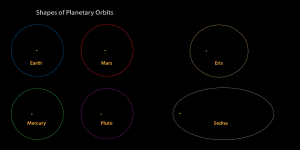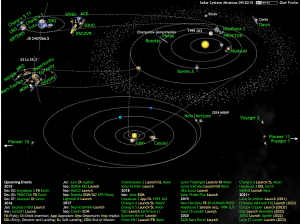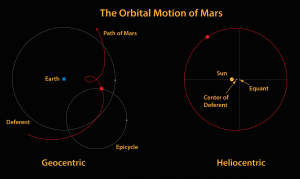Blog
The Curious Case
of Planetary Orbits
11 October 2015
 Brian Koberlein
Brian KoberleinThe planets of our solar system move in ellipses. We’ve known this, so we are told, ever since Johannes Kepler devised his laws of planetary motion in the early 1600s. While it’s true that orbits are (approximately) ellipses, they aren’t as elliptical as you might think, and that’s largely due to the way the solar system is typically presented. Take, for example, a figure showing the space missions currently active in our solar system.
 Olaf Frohn CC BY-SA 4.0
Olaf Frohn CC BY-SA 4.0Like many such figures, the solar system is shown with a tilted perspective, and so the orbits appear highly elliptical. In reality, the orbits of most planets are extremely circular. If we were to draw Earth’s orbit as a perfect circle 100 meters (328 ft) across, it would be accurate to Earth’s actual orbit to with 14 millimeters (0.5 inches). When Kepler proposed his model, only the orbits of Mercury and Mars were known to be non-circular. Whether they were true ellipses was still a matter of debate. This is part of the reason why Kepler’s model wasn’t fully accepted until Newton developed his theory of universal gravity in the late 1600s.
While ancient astronomers thought planetary orbits were circular, they didn’t think they were simple circles. One of the consequences of elliptical orbits is that planets orbit not about the center of the ellipse, but about a point off-center known as the focus. This offset is far more noticeable than a slightly elliptical shape. So early astronomers proposed circular orbits known as deferents that were shifted off center. Since most early models of the solar system placed the Earth at the center, a single circular path didn’t agree well with observed planetary motion. In the third century BC Apollonius of Perga proposed the addition of epicycles, which moved along an off-center deferent.
Originally it was proposed that the deferent and epicycle rotated at constant rates. This explained why planets would appear to move more quickly at some points in its orbit and more slowly in others. But by the second century AD observations had become accurate enough that they couldn’t explain the variation in speed. So Claudius Ptolemy introduced an idea as the equant. Basically the equant of an orbit is a point from which a planet would appear to move along the deferent at a constant speed. Since the equant was not the center of the deferent, the planet would vary in speed along its orbit.
 Brian Koberlein
Brian KoberleinCalculating the motion of planets using deferents, equants and epicycles may have been complex, but it was accurate. When Copernicus proposed a Sun-centered model of the solar system in the mid 1500s, it wasn’t more accurate than earlier geocentric models, but it did make the calculations simpler. A heliocentric circular orbit of Mars with an equant to describe its varying speed is extremely close to the actual motion. Even astronomers who didn’t think the Earth actually orbited the Sun began to use the Copernican model for its computational advantages.
While Kepler’s introduction of ellipses was an elegant solution for planetary motion, it was still merely an approximate description. Newton showed that a single planet orbiting the Sun would have an elliptical orbit, but in the real solar system planets tug upon each other gravitationally, and their orbits are perturbed slightly from a perfect ellipse. In reality no planet has a truly elliptical orbit. Kepler’s laws, as they’ve come to be known, are a beautiful but approximate consequence of a deeper gravitational truth.